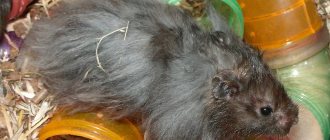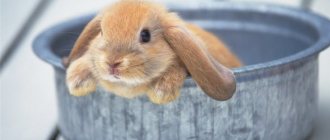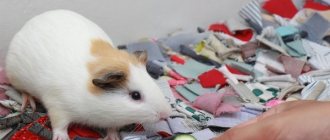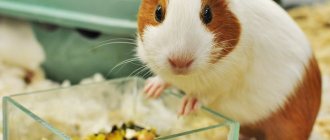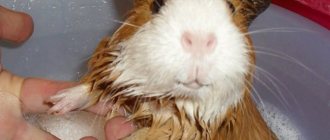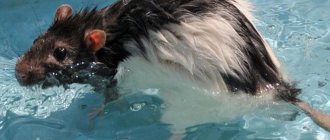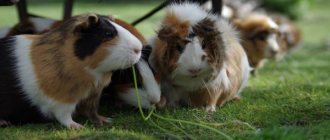When keeping any pets in a house or apartment, the issue of hygiene arises. Nature provides opportunities for self-cleansing of animals. This process is not always associated with water procedures.
Guinea pigs are very clean. But, despite the intriguing name, they do not like to swim. It is possible that a specific smell will be heard from the animal. And then you can’t do without water and shampoo. It is important to know how to bathe your guinea pig correctly so as not to harm it.
When should you bathe your guinea pig?
It is better not to carry out bathing procedures for pigs without compelling reasons. This is extra stress for her. Washing your guinea pig just for fun is not worth it.
Arguments that speak in favor of swimming:
- The rodent's fur is overgrown with clumps, dirty areas are clearly visible;
- the animal’s fur coat has become dull; despite all his efforts, he is unable to put it in order on his own;
- before the “introduction”, in preparation for the upcoming exhibition, bathing guinea pigs is a common procedure;
- sticky growths have formed in the tail area;
- a bad smell began to emanate from the animal.
Most often, pigs are bathed if they spend most of their time in enclosures built in the yard.
Ready for the swim
First you need to prepare equipment for bathing the animal.
For water procedures you will need:
- Bathing container (basin, bathtub or washbasin).
- Cotton buds.
- Towel.
- Shampoo for rodents.
When choosing a shampoo, you should consult your veterinarian.
If your bathing place is a bathroom, then you should prepare for this a little in advance.
In order not to cause fear in the rodent before bathing, 2-3 days before, if this is the first bath, go once or twice a week, if you are already accustomed to the bath, you should bring the animal into the bath, give it treats there, and stroke and talk to it, holding on the knees. This way, your pet will associate the bathroom with pleasant moments and there will be no stress factor.
You need to fill the bathing container with warm, never hot, water. Its level should be 2.2.5 cm. We should place a towel or rag on the bottom of the container so that the pig’s paws do not move apart. From the shower or from the scoop, carefully, little by little, wet the animal, all the while stroking it with massaging movements and talking to it.
If your rodent is nervous, give him a treat. Try to avoid getting water into your pig’s nose and ears; therefore, you should not particularly wet or wash your head. Some pigs like it when warm water flows from the tap in a thin stream, and they themselves are happy to stand under it, enjoying it.
The shampoo should be applied to the back of the animal, and gradually, using massaging movements, move towards the head. Don't wash your hair. Same with the belly and paws. The shampoo should foam well and soap bubbles should form.
You should rinse your guinea pig thoroughly, as unwashed shampoo can harm the animal's gastrointestinal tract.
When should you not bathe your guinea pig?
It is not always possible to wash your guinea pig. Factors that do not allow this to be done at this point in time:
- The pet is still very small, its delicate coat is not yet dirty;
- when a rodent has just changed its place of residence, you need to wait until it gets used to it and stops worrying about its housewarming;
- This cannot be done in the cold season, there is a very high probability of hypothermia from a draft;
- Swimming is strictly contraindicated for a pregnant female;
- a sick animal may not tolerate bathing, you need to wait until it recovers;
- If, when immersed in water, the pet desperately escapes from your hands and squeaks loudly, bathing should be postponed and limited to wiping the fur with a damp cloth.
Before you decide to bathe a capricious pet, you need to think carefully about whether this can be done? If there is at least one of the contraindications, the water activity should be abandoned until better times.
At what age can you bathe?
Small guinea pigs should not be bathed. Their immunity has not yet been formed, and their exposure to stress is extremely high. Young animals have a hard time withstanding temperature changes; a draft after a bath in almost 100% of cases leads to a cold and further health complications.
It is recommended to bathe pigs at home no earlier than they are 5–6 months old.
In what cases can you not do without water procedures?
Guinea pigs are by nature very clean animals; they brush their fur very often.
However, in some cases you cannot do without bathing:
- if the wool is heavily contaminated with the products of their vital activity. In this case, you should thoroughly clean the cage, change the filling in it (it should be at least 5 cm), and cut long-haired pigs into a bob;
- if you notice crusts or deposits in the area of the sebaceous glands;
- The animal emits unpleasant odors.
How to prepare an animal for a bath
There are very rare exceptions to the rules when a pig willingly dives into water and also swims with pleasure. This means that the genes of distant ancestors who lived near water made themselves felt.
Most often, if an animal unexpectedly finds itself in the water, it will be perceived with aggression and fear. To avoid such a negative reaction, the pig should be prepared in advance for the fact that it will have to take a bath.
At least 5 days before the planned bathing, they begin to accustom the animal to going to the bathroom. He needs to get comfortable in a new place and perceive this place without fear or suspicion. If the animal gets scared, you can calm it down with gentle intonations of your voice, give it your favorite treat, or pet it.
You can train your rodent to brush its hair in the bathroom. When he gets used to the environment, the next stage begins: carefully place him in a cup without water. The bath procedure will be carried out in this container in the future. The next day, turn on warm water. The animal's paws will get wet, it will explore a new sensation in a familiar environment, without fear listening to the sound of falling water.
Washing guinea pigs will not be difficult if all these preparatory steps have been completed.
Do rodents like to swim?
Rodents living in their natural environment do not like to bathe. This surprises many, because the name of the animal is associated with water. Although the ancestors of guinea pigs knew how to swim, dive and even stay underwater for several minutes, their descendants live on land and do not go into the water without reason.
In the wild, rodents often have to cross various streams or bodies of water. However, guinea pigs swim not for pleasure, but to escape from enemies. After heavy rains and floods, animals often find themselves in the water. Despite this, they do not have a special love for water procedures.
How to bathe a guinea pig correctly
If you place an animal in a bathtub or in a cup with high sides, it will have the desire to jump out of there. You need to be prepared for the fact that the soaped body is very slippery, and it will be difficult to hold the pig with your hands. It must be remembered that falling from any height means inevitable injury, sometimes incompatible with life.
If you carefully think through the place for swimming, the procedure will be easier. It is possible that your pet will even enjoy bathing and will ask you to do it from time to time.
The water in the basin, which will serve as a bath, should be filled no more than to the level of the pet’s abdomen.
The pig will be more comfortable if a small woven cotton napkin is placed at the bottom of the bathing container. By grabbing it with her paws, she will stand more confidently.
Even if the animal normally tolerates the sound of a running stream from a tap, turn on the water if absolutely necessary. It is convenient to water the animal from a scoop without lifting it high.
When the entire coat is wet, apply shampoo. When a guinea pig bathes, it is advisable to calm it down with a calm monologue and gentle stroking.
You need to foam the shampoo carefully, without making sudden movements. When massaging your back, you should not press hard on it. Particularly dirty areas, especially in the tail area, are cleaned with soapy cotton wool.
While your pet is in the basin, you need to make sure that water and detergent do not get into his eyes or ears. This may cause conjunctivitis and otitis media.
The detergent is washed off as thoroughly as possible to prevent further entry into the rodent’s food tract.
Long-haired animals could use a little balm, after which the hair will be combable better and will become smooth and shiny.
Immediately after finishing the bathing procedures, the animal is wrapped in a soft, slightly warm towel to absorb water. He is released into the cage after he has dried thoroughly.
Process description
Don't rush into bathing if you see that the adaptation has not gone well. Only when the pig is no longer afraid of the bath, when water flowing from the tap does not frighten it, can the animal be bathed. The procedure begins “on land”. About 20 minutes before bathing, the animal’s sebaceous glands should be lubricated with cosmetic oil (any kind will do). This will soften the crusts, which will allow them to fall off faster and easier in the water.
It is not difficult to wipe the sebaceous gland: drop the oil onto a cotton pad and rub lightly. Be careful not to get any oil on your pig's fur.
Be sure to wear gloves before washing. It is possible that the pig will get scared and start kicking and biting - you need to protect yourself.
Bathing a guinea pig involves several steps.
- It is more convenient to bathe the animal in a sink. Doing this in a bathtub or basin is not very correct: the pig will see the sides and may try to jump out of the container. And in a soap solution the animal is very slippery, so you can’t rely on your own dexterity. You need to be very careful in the water - if the pig breaks out and falls, it can be seriously injured, and there is a risk of death.
- Close the drain in the sink and add enough water so that it evenly touches the pig’s tummy. It is wise to place a small cotton napkin at the bottom of the sink so that the animal can grab onto it with its paws - this way the animal will be calmer.
- Place the pig in the water, stroke it, talk calmly and affectionately.
- Using your hands, gently wet your pet's fur. If you have a long-haired pig, you can take a small ladle or glass and pour water from the ladle into the animal in a thin stream. But do not raise the container very high: the pig will be scared.
- When the fur is sufficiently moisturized, apply literally a drop of shampoo to your hand (no more needed). Take baby shampoo, neutral, if there is nothing else. But it is better, of course, to purchase a special product at a pet store. Shampoos for rabbits and cats are quite suitable, but do not use products for dogs - they are very aggressive towards pigs. Try not to wash your pet with simple soap; it contains a lot of acids, which will make the fur brittle and hard.
- Lather the shampoo in your hands as usual and apply it to the animal’s fur. The foam should not get on your head, go no further than your neck. Gently, with maximum delicacy, rinse the sebaceous gland area. Remove the crusts - they are already soft and come off easily.
- Start washing the fur, do it slowly, without sudden movements. At the same time, water the animal with water from a ladle. No moisture should get into the pig's ears and eyes. This is fraught with otitis media and conjunctivitis, which will add to the basic fear.
- For long-haired pigs, owners often complicate the washing process with the additional use of balm. There is no great need for this, unless, of course, you are preparing an animal for an exhibition. True, after the balm, combing the fur is not so difficult. Leave it on the fur for a minute and rinse off. But don’t get carried away - you don’t need to wash your pet this way every time.
There is nothing complicated in the rules; if you do not ignore any instructions, then occasionally, if necessary, you can bathe the animal at home. If the first bathing experience remains positive, this does not mean that the procedures can be more frequent.
After bathing procedures, clean the pig's sebaceous gland and anal pocket again. Wipe the sebaceous gland area with a cotton swab, then treat with an antiseptic (regular chlorophyllipt will do). To clean the anal pocket, you need to slightly press on the pig's lower abdomen, the pocket will protrude, with a cotton swab soaked in oil, you will quickly clean it. Avoid unnecessary friction. You can’t do manual cleaning very often, but try to do it once every month and a half.
To dry your pet, you can use a hairdryer on a gentle setting. But if the pig is afraid of sharp sounds, it is better not to use the device.
If you see that the animal is scared, just use a dry towel, remembering to change the fabric.
After bathing, you do not need to take the animal outside for at least a day. You cannot leave a rodent in a cold room or in a draft. Do not let a wet animal into a cage with sawdust - it will stick to the fur. After a bath, your pet deserves a delicious dinner, please the animal, it is good for him to calm down.
To learn how to wash a guinea pig, watch the following video.
How to properly dry guinea pigs after bathing
Dry the animal using a soft towel. Gently massage the back, changing the wet towel to a dry one if necessary. When the fur coat becomes almost dry, it needs to be combed. If this is not done immediately, the wool may become matted.
Blow drying your pet is not a good idea. Most animals are terrified of this device. You can scare a pig so much that bathing it next time will be a big problem. Pet owners justify blow-drying by the coolness of the room and the fear of catching a cold in their pet. However, bathing an animal in the cold is generally contraindicated.
A hot air stream from a hairdryer can easily dry out the animal's skin or even burn it. If you choose a low temperature, your pig will catch a cold. Therefore, there are more dangers from a hairdryer than benefits.
Bathing and brushing
Fluffy rodents do not like water treatments, so treat them only as a last resort. Even severe contamination can be removed by treating the desired part of the body. If you decide to swim, the water temperature should be no more than thirty-eight degrees; if necessary, you can use baby shampoo. But remember that you absolutely cannot get your head wet. After the procedure, wrap the animal in a towel and dry it, possibly using a hairdryer, otherwise it will get cold.
Short-haired pigs clean and comb their fur with their teeth. But help your pet periodically, and during shedding, comb the fur twice a week. With long-haired animals everything is more complicated. They need to be brushed regularly to prevent their fur from becoming tangled. Accustom your animal to this procedure from an early age, then it will not cause any special problems. Take your pet on your lap, lightly dampen the coat and use a comb to comb the hair, then run through it with a soft brush. All necessary accessories can be found at a pet store.
What should shampoo be like?
Detergents intended for humans are not suitable for pigs. When the question arises of how to wash your pet, you don’t need to listen to your friends who claim that they get by just fine with soap or regular shampoo. Veterinarians warn: small animals have very sensitive skin; it is easily irritated by improperly selected detergents.
If you choose between soap and shampoo, the second remedy is preferable. Soap is more difficult to rinse off and also makes the coat hard.
Special shampoos for rodents are sold in every pet store or veterinary pharmacy. Their price is not so high that you save on your pet’s health. Products intended for bathing dogs are not suitable. You can buy hygiene products for cats and rabbits.
A brief overview of detergents for rodents:
- “Piggy” - this pet shampoo contains hypoallergenic plant components and glycerin in its base. This product will give the animal silky and shiny fur.
- “Shustrik” is a specially developed detergent composition without dyes for animals that are sensitive to chemicals. The value of this shampoo is that it moisturizes the skin and has an anti-inflammatory effect. The fur will comb well, without tangling.
- Api-San Royal Groom is a fortified cleaning product that, thanks to selected herbal ingredients, moisturizes the skin well, acts as an effective bactericidal and healing agent, and treats dandruff.
- Beaphar is a pet shampoo that has no side effects, does not irritate sensitive skin, gently cleanses, foams well, and is environmentally friendly.
If it is not possible to purchase pet shampoo, and the contamination is severe, it is permissible to bathe the guinea pig at home with shampoo or soap intended for babies. But it is not recommended to constantly get out of the situation in this way.
Zoo shampoo is purchased in advance, in parallel with the equipment for the cage, so that if necessary it is always at hand.
Drinking regime and nutrition
It is more convenient to feed a guinea pig with ready-made concentrated food, at the rate of 20 g per kilogram of animal weight. If you give crackers, white bread or crispbread as a treat, you should know that such food is part of the finished food. Therefore, it must be given in accordance with the permissible volume.
It is worth adding 50 grams of succulent feed and fresh hay to the finished concentrated mixture. This type of feeding allows you to maintain the pig’s health at a high level, since all food has a balanced composition and is rich in vitamins and minerals.
Water is of great importance for rodents. Therefore, it is worth washing the sippy cup every day and pouring fresh, clean water. As vitamins, you can add ascorbic acid to the sippy cup at the rate of 30 ml per 100 ml of liquid. Vitamin C solution can be obtained from a veterinary clinic or pharmacy.
Final procedures
It will not be possible to completely dry the animal right away; this process will be completed naturally within a few hours. Therefore, after a bath, you should not take the animal outside for about a day. Drafts and cold rooms are strictly contraindicated.
After finishing bathing, experts recommend wiping the animal’s sebaceous gland in the tail area with a cotton pad and treating this area with an antiseptic, for example, chlorhexidine.
There should be no sawdust in the cage. They may stick to the fur. During this period, you can lay paper or waffle towels on the bottom of the cage.
Before putting a washed and dried animal into the cage, you can offer it “snacks”. He will receive such encouragement for long-term patience with gratitude and remember this pleasant moment. It will be much easier to wash your guinea pig next time.
Be careful with drafts
Before you get ready to bathe your pig, thoroughly check your home for drafts. A draft that may seem barely noticeable to you can cause serious harm to your pig after bathing.
These gentle creatures are extremely sensitive to drafts, and after bathing, if exposed to a draft, the pet can very quickly catch a cold and subsequently get sick. And even if it seems to you that it’s summer outside and the temperature is quite bearable, don’t be mistaken.
These animals are much more sensitive to temperature changes, especially when the fur is wet. Swimming in winter needs to be discussed separately.
It is generally not advisable to take the animal out of the bathroom and all procedures for toweling and drying with a hairdryer should be carried out there until the animal is completely dry.
Even after this, it is better to take it into the room in a towel and give the pig a couple of minutes to acclimatize, because our homes will not always be well heated in winter.

